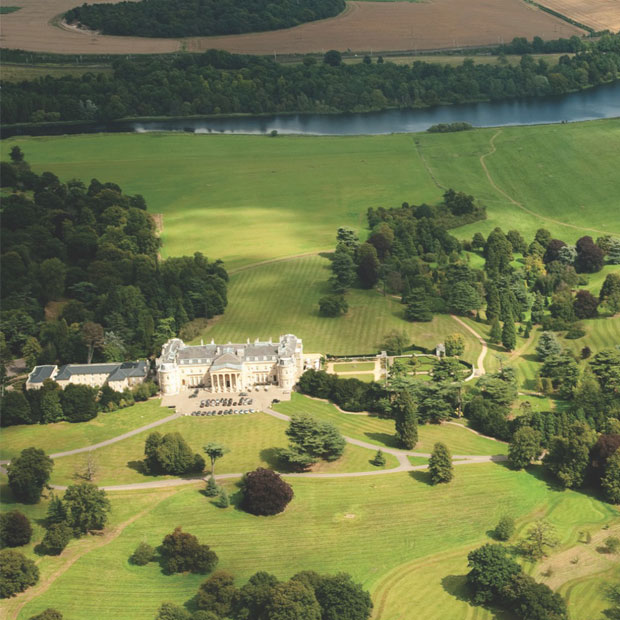Royal County Down
Why Royal County Down stands out is fairly simple: it has an intricate design that maximizes the sublime property it inhabits

Newcastle, Northern Ireland
Old Tom Morris (original design, 1890); Harry Vardon (updates, 1908); Harry Colt (updates, 1926)
Semi-Private
$$$$
The Greatest Stretch In Golf | Royal County Down
Royal County Down: The Greatest Stretch in Golf
Royal County Down and the Irish Open
Like many of the great links golf courses, Royal County Down’s history ties back to the railroad. The genesis of the club came from the train stop in Newcastle. This train station would become where Royal County Down rounds started and ended during the club’s early days. The course made a long list of changes throughout its first 40 years. Originally laid out by its membership, the club then brought Old Tom Morris in to create a new 18 holes.
In the early 1900s, the membership (George Coombe in particular) took matters into his own hands, updating the golf course. Finally, Royal County Down enlisted Harry Colt to make final revisions to the course, creating the vast majority of the 18 holes that are on site now. A few of Colt’s major revisions include adding Nos. 4 and 5, as well as turning two of the existing holes into No. 9, now one of the most photographed and celebrated holes in all of golf. On top of the addition of these holes, Colt’s work also removed some of RCD’s propensity for blind shots. While players will still face them, Colt’s work made many shots at RCD more visible. This amalgamation of different work through the years has given us one of the most sublime golf experiences in the world.
Take Note…
Quite the room. When Royal County Down’s first and 18th holes started and ended at the train station, the club used to have rooms for members in the train station itself.
Creating the ninth. Harry Colt’s creation of the ninth was done through a few key routing changes. The eighth green was moved up to its current ridge from its existing location down by the first green. By moving the eighth green up to the top of the ridge it allowed Colt to create the ninth, which has possibly the most stunning tee shot in all of golf with the spire from the Slieve Donard and the Mourne Mountains in the distance.
Don’t skip the pre-round meal. For those that love a good breakfast, I would recommend the Railway Cafe, which boasts one of the best cups of coffee you will find in Northern Ireland.
Favorite Hole
No. 3, par 4, 423-475 yards
Is this possibly the most difficult place to pick a favorite? The day I am writing this, I have decided the third is mine. This brutish par 4 is broken up by some scabs which cut across the fairway. Hug the right side and be rewarded with a look at the green and a shorter approach. Play left and away from the trouble right and you get a long, completely blind approach into this green. The dune that sits behind the green and ocean on the left make this as dramatic a hole as you will find in golf.
Favorite Hole
No. 3, par 4, 423-475 yards
Is this possibly the most difficult place to pick a favorite? The day I am writing this, I have decided the third is mine. This brutish par 4 is broken up by some scabs which cut across the fairway. Hug the right side and be rewarded with a look at the green and a shorter approach. Play left and away from the trouble right and you get a long, completely blind approach into this green. The dune that sits behind the green and ocean on the left make this as dramatic a hole as you will find in golf.

{{content-block-course-profile-royal-county-down-001}}
Overall Thoughts
The idea of a “best course” is a fallacy to me. Great golf courses are works of art. The “best” to me is not necessarily the best to someone else. It’s subjective and ever changing. That being said, on a given day, Royal County Down might be my answer to the question I get almost every time I meet someone who likes golf: “What is the best course you have played?”
Why Royal County Down stands out so much is fairly simple: it has an intricate design which maximizes the sublime property that it inhabits. It also feels the most natural of any world-class course that I have played. It’s a particularly welcome contrast to the way many premier courses limit their own connection to the natural elements and landscape by chasing perfect playing conditions. Royal County Down offers perhaps the most raw golf experience in the world. As the golfer, you’re asked to tackle one of the most extraordinary golf environments. In most cases you will lose. The wind whips, the sand dunes are spectacular and scaled for every fashion of golf thanks to Harry Colt’s phenomenal routing tweaks. Royal County Down is unapologetically itself for the vast majority of the round and that is what makes it great. It’s beautiful, filled with natural blindness thanks to the sublime topography, and painstakingly difficult.
What makes Royal County Down so difficult is the natural elements and how the architects have amplified them through the years. RCD’s sand dunes are the perfect size, big and dramatic but not too large to be integrated into the golf course. Many links courses feature massive dunes that are amazing to look at, but the variety suffers when every hole plays through the dunes, rather than along them. At Royal County Down there are a number of holes that play on top of the dunes. The stretch from No. 6 through the tee shot on No. 9 is a particular standout. It’s the climactic part of the front nine and is the most exposed moment in the round. Sitting up high above the Dundrum Bay, there is nowhere to hide from the relentless Irish Sea wind. Contrast the front nine of RCD with that of Portstewart and you see the supreme difference in the dunes. Two of the greatest front nines in golf in this author’s opinion, Portstewart’s is a far cry from RCD because all the holes at Portstewart play below the stunning dunes. It limits the amount an architect can do with holes. The largest dune on property at Royal County Down is part of the backdrop on the first three holes, and it’s stunning to look at. That dune is a great example of one too big for golf; it sits on Royal County Down’s Annesely Links, and the holes were routed around the dune by Martin Ebert. Those holes are unforgettable on the Annesely, but each one is fairly similar: a big dune on the left and flatter ground around it.
The other aspect of RCD that is different than many of its famous links neighbors is its routing. It returns at No. 9, and doesn’t feature the traditional links out and in routing. RCD’s routing on the front nine plays out the first three holes before it jogs up and down the central dunes. This routing creates a diversity in the hole directions and the manner in which each hole relates to the courses main feature the sand dunes. The main dunes are situated along the coast and about one hundred yards inland. The first three play through the two dunes and are filled with tremendous smaller contours that sit in the fairways. The fourth and fifth play alongside the inland dune ridges before the sixth, seventh, eighth, and the ninth tee shot play along the top of it. After the ninth tee, golfers find themselves back below the dunes for the ninth approach and the entire 10th before the 11th brings you back up onto the dunes. The 11th, 12th, and 13th play along the back side of the dune ridge before the routing moves to a more subtle inland section for the closing five holes.
{{content-block-course-profile-royal-county-down-002}}
Much of the discourse around Royal County Down centers around the spectacular first 13 holes and how the final few are a bit of a let down. The land at Royal County Down creates the most spectacular start in all of golf, and 13 of the greatest holes in the entire world. This is all thanks to the land, which sadly doesn’t have room for more golf on the dramatic dunes. Some have floated the idea of flipping nines to generate a better finish, but I’d rather have the 18 laid out the way it is. It’s like a book that is astoundingly engaging from the first page that hits an excellent dramatic climax before meandering a bit to a resolution in the final few pages. The close to RCD is by no means bad, it’s just not quite as good as the first 13, which I would remind all readers is arguably the best 13 holes that any course in the world has.
There are things that can be done to improve the closing holes. Donald Steel redesigned the 16th and it’s a bit mundane. The old 16th was shorter and played blind over a dune. Some loved it, others hated it. What’s there today is a rather optionless short par 4. It plays over dramatic land but the land is hardly used for strategy. Originally the hole had a lower fairway to the right, and I believe that would make the hole and the layup a bit more interesting. The greenside bunkers also exemplify a plague of over-bunkering. These bunkers lack the character seen on the first 15 holes from a shaping and styling standpoint. They’re homogenous and redundant, and the same goes for the myriad of added bunkers on 18. They make RCD’s closing stretch far more target-oriented than the first 15 holes. Removing most of the added bunkers on the 18th would greatly improve the closing hole. It has a neat green for a par 5, narrow with falloffs on either side forcing players to contemplate whether going for it is the best decision.
Sandwiched between the aforementioned flawed holes, I find the 17th to be quite good except for the inexplicable sand scrape at the bottom of the hollow that sits in the desired driving area for most. The 17th used to have a natural spring there, which was predictably replaced by the “Scrape King” Martin Ebert. This scrape resembles nothing else on the rest of the golf course, and frankly looks silly at the bottom of the 17th fairway. Literally any other feature would be better, including the old water hazard. Strategically the hole is great; it asks players to make a decision, and laying way back makes for a tremendous approach shot to a well-designed green.
3 Eggs
Could RCD’s closing stretch be better? Maybe a little, but I wouldn’t change anything from the first 15 holes to make it better. No course that I have played possesses as many spectacular holes as Royal County Down. There are more complete golf courses around the world, but none that give you the same “golf high” that RCD’s start does. It is without a doubt one of my favorite courses in the world, if not my favorite. And it’s one I dream of returning to.
Course Tour

{{content-block-course-profile-royal-county-down-003}}
Additional Content
– Eggsplorations: First Impressions of Royal County Down
– A Northern Ireland Trip Eclectic 18
– Royal County Down: The Greatest Stretch in Golf
The Greatest Stretch In Golf | Royal County Down
Leave a comment or start a discussion
Get full access to exclusive benefits from Fried Egg Golf
- Member-only content
- Community discussions forums
- Member-only experiences and early access to events








.jpeg)











Leave a comment or start a discussion
Lorem ipsum dolor sit amet, consectetur adipiscing elit. Suspendisse varius enim in eros elementum tristique. Duis cursus, mi quis viverra ornare, eros dolor interdum nulla, ut commodo diam libero vitae erat. Aenean faucibus nibh et justo cursus id rutrum lorem imperdiet. Nunc ut sem vitae risus tristique posuere. uis cursus, mi quis viverra ornare, eros dolor interdum nulla, ut commodo diam libero vitae erat. Aenean faucibus nibh et justo cursus id rutrum lorem imperdiet. Nunc ut sem vitae risus tristique posuere.